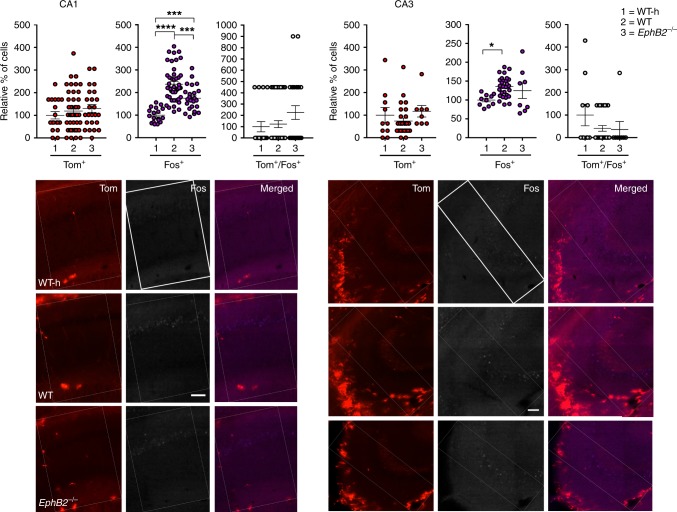Fig. 3.
Analysis of Tom+ and Fos+ learning-associated neurons in the hippocampus of EphB2 mutant mice. Neurons activated exclusively following encoding (Tom+ single-positive), exclusively following sound-cued retrieval (Fos+ single-positive), and following both encoding and retrieval (Tom+/Fos+ dual-positive) were imaged and counted in the CA1 and CA3 regions from EphB2−/− mutants and WT littermates subjected to FC and WT home cage controls not subjected to FC (WT-h). Scatter plots show the number of Tom+ single-positive neurons, Fos+ single-positive neurons, and Tom+/Fos+ dual-positive neurons. Representative confocal images of Tom+ and Fos+ labeled neurons in the CA1 and CA3 regions are shown with the boxes indicating quantification areas. For CA1: n = 18 hemisphere WT-h, n = 44 hemisphere WT, and n = 24 hemisphere EphB2−/−; Fos+ single-positive neurons, one-way ANOVA, F(2,83) = 30.52, p < 0.0001; Tukey multiple comparison test; WT-h vs WT q(60) = 10.85, p < 0.0001; WT-h vs EphB2−/− q(40) = 5.30, p = 0.0010; WT vs EphB2−/− q(66) = 5.453, p = 0.0007. For CA3: n = 10 hemisphere WT-h, n = 28 hemisphere WT, and n = 8 hemisphere EphB2−/−; Fos+ single-positive neurons, one-way ANOVA, F(2,43) = 4.31, p = 0.0197; Tukey multiple comparison test; WT-h vs WT q(36) = 4.15, p = 0.0145; WT-h vs EphB2−/− q(16) = 2.24, p = 0.2629; WT vs EphB2−/− q(34) = 1.16, p = 0.6928. Error bars are standard error of the mean (SEM); *p < 0.05, ***p < 0.001, ****p < 0.0001. Scale bar = 100 μm

